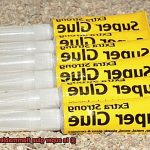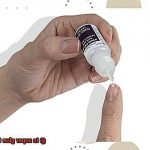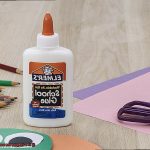Title: The Truth Unveiled: Is Dried Super Glue Still Flammable?
Introduction:
Contents
- 1 What is Super Glue?
- 2 How Does Super Glue Work?
- 3 Is Super Glue Flammable in its Liquid Form?
- 4 What is the Chemical Composition of Super Glue?
- 5 What are the Volatility Properties of Super Glue?
- 6 How Does the Drying Process Affect Flammability?
- 7 Is Dried Super Glue Non-Flammable?
- 8 Potential Fire Hazards Associated with Super Glue
- 9 Conclusion
We’ve all heard those wild tales of super glue turning into a fire-breathing dragon once it’s dried. It’s enough to make you question whether this adhesive is secretly plotting to burn down your house. But fear not, my friends, because today we’re here to debunk the flammability myth surrounding dried super glue.
Now, let’s get one thing straight – super glue, or cyanoacrylate adhesive if you want to impress your friends with fancy words, is a handy fix-it-all for everything from broken toys to shattered ceramics. It’s a superhero in the world of adhesives. But does it keep its fiery nature even after it dries up and hardens? That’s where the rumors start flying.
So buckle up and join us on this enlightening journey as we explore the composition and properties of super glue. We’ll separate fact from fiction and arm ourselves with knowledge about whether dried super glue poses any real danger when it comes to flames.
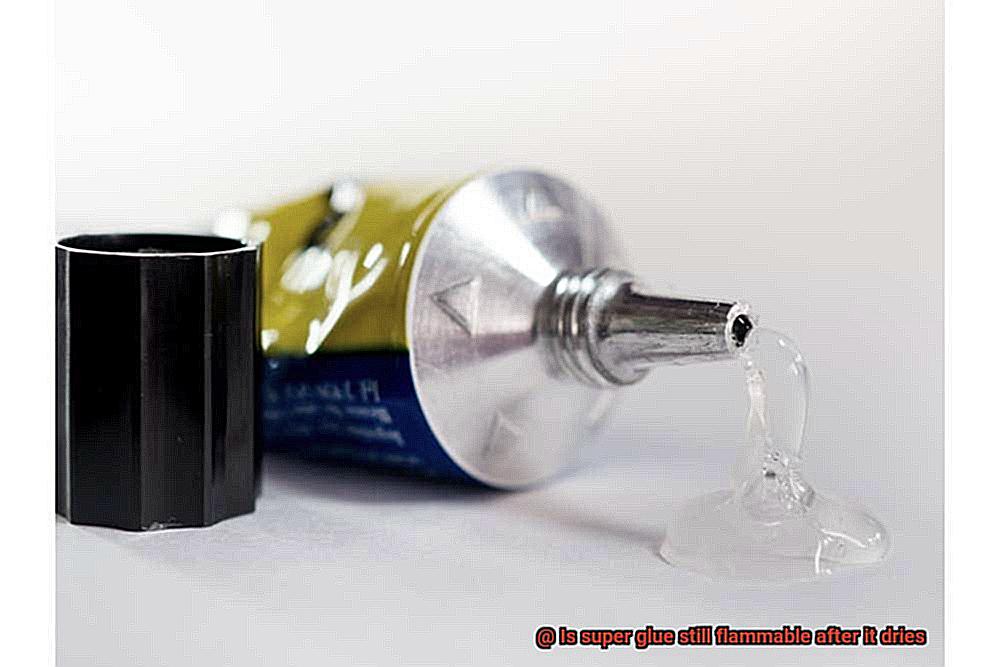
Stick around (pun intended) as we dive deep into the flammability risks associated with dried super glue. Let’s put an end to these burning questions once and for all.
What is Super Glue?
Super Glue, also known as cyanoacrylate adhesive, is a remarkable adhesive that has revolutionized the way we bond materials together. From its accidental discovery to its fast-drying capabilities and versatile bonding strength, Super Glue has become an essential tool in various industries and everyday household tasks. In this blog post, we will dive into the world of Super Glue, exploring its properties, applications, and considerations for safe use.
The Secret Behind the Bond:
Super Glue’s secret lies in its main ingredient, cyanoacrylate. This acrylic resin is a monomer that undergoes polymerization when exposed to moisture, creating strong chains of polymer that form an unyielding bond. This chemical reaction happens within seconds or minutes, depending on humidity levels and adhesive thickness. The rapid bonding action of Super Glue allows for quick and efficient repairs or projects.
Versatile Bonding Power:
Super Glue’s versatility is one of its standout features. It adheres to a wide range of materials, including plastics, metals, ceramics, rubber, and some fabrics. Whether you’re fixing broken objects or crafting DIY projects, Super Glue provides a reliable bond on both porous and non-porous surfaces. Its ability to bond different materials makes it a go-to adhesive for various applications.
Viscosity Options:
Super Glue comes in different viscosities to cater to various bonding needs. Thin varieties are ideal for smooth surfaces and tight-fitting joints, allowing the glue to seep into small spaces for a secure bond. Gel-like versions are perfect for vertical applications or bonding porous materials as they stay in place without running or dripping. Regardless of viscosity, all types of Super Glue share the same rapid curing time and excellent bond strength.
Cautions and Considerations:
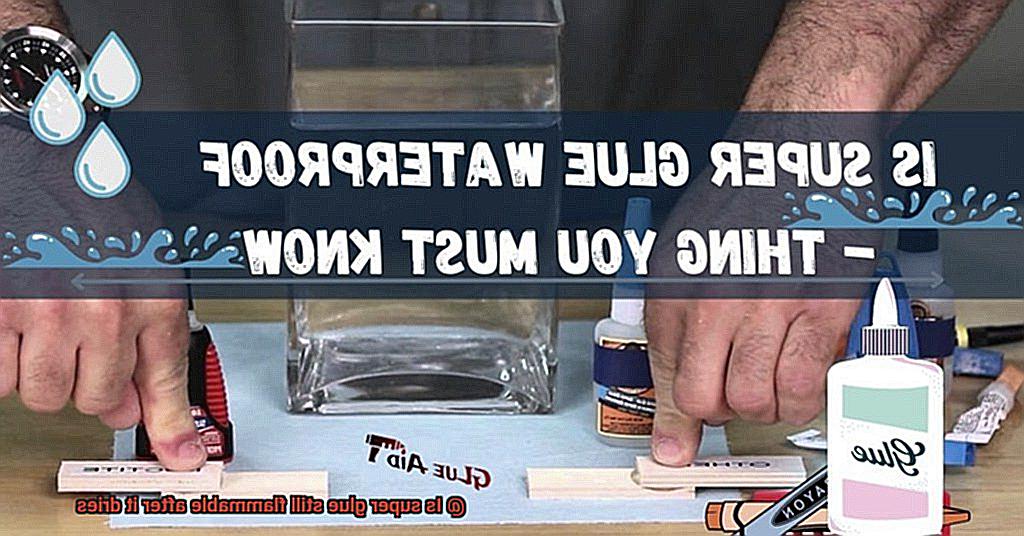
While Super Glue is a remarkable adhesive, it’s crucial to exercise caution during use. Avoid applying it near open flames or sparks, as the solvent used in its formulation can be flammable in its liquid state. Additionally, be mindful of the materials you’re bonding; certain plastics with low surface energy may not form a strong bond with Super Glue. It’s always recommended to test the adhesive on a small, inconspicuous area before applying it to larger surfaces.
How Does Super Glue Work?
Super glue, the superhero of adhesives, has revolutionized the way we bond materials together. Its fast-drying capabilities and versatile bonding strength have made it a staple in every toolbox and crafting kit. But have you ever wondered how this magical adhesive actually works?
The secret behind super glue’s effectiveness lies in its chemical composition. Super glue is a type of acrylic resin that is derived from cyanoacrylate monomers. These monomers start off in a liquid form, but as soon as they come into contact with moisture in the air, they rapidly polymerize. This fancy word simply means that the liquid glue transforms into a solid within seconds.
Imagine you’re gluing two pieces of broken ceramic back together. As you apply a thin layer of super glue to the surfaces, the moisture in the air triggers the polymerization process. The liquid glue quickly spreads and forms a tight seal between the two pieces. And just like magic, within seconds, you have a solid bond that will hold your ceramic together.
The polymerization of super glue is also an exothermic reaction, which means it releases heat as it solidifies. This heat helps to speed up the curing process even further. So not only does super glue work fast, but it also generates some serious heat. Be careful not to touch it while it’s drying, or you might end up with a nasty burn.
One of the coolest things about super glue is its ability to bond strongly to a wide range of materials. Whether you’re fixing a broken plastic toy or sticking metal parts together, super glue has got your back. It adheres well to both porous and non-porous surfaces, including rubber, ceramic, metal, and even skin. Yes, you heard that right – it can even be used for medical purposes.
But before you go crazy gluing everything in sight, remember that proper surface preparation is key to a successful bond. Make sure the surfaces are clean, dry, and free from any oils or debris. A little roughening of the surface can also enhance the adhesive strength.
Is Super Glue Flammable in its Liquid Form?
Super glue, also known as cyanoacrylate adhesive, is a fast-drying and strong adhesive that is commonly used for bonding various materials. It’s the go-to adhesive for fixing broken items or creating strong bonds, but is it flammable in its liquid form?
The answer is yes. Super glue, in its liquid form, is highly flammable. The main ingredient in most commercially available super glues is ethyl cyanoacrylate, which has a low flash point. This means that it can ignite at relatively low temperatures, typically around 176 degrees Fahrenheit (80 degrees Celsius).
When exposed to heat or an open flame, super glue releases flammable vapors that can easily ignite and cause a fire. So, it’s crucial to handle super glue with caution and avoid using it near sources of heat, sparks, or flames.
To minimize the risk of fire, proper storage of super glue is essential. Keep it in a cool and dry place away from any potential ignition sources. Remember, prevention is key when it comes to fire safety.
Once super glue dries and cures, it forms a hard and solid bond between surfaces. At this stage, the adhesive itself is no longer flammable. However, if exposed to intense heat or an open flame, the dried super glue can still burn and release toxic fumes.
It’s important to note that while the dried super glue may not be flammable, the materials being bonded together could be flammable. So, exercise caution when using super glue on flammable materials to avoid any potential fire hazards.
In conclusion, while super glue is highly flammable in its liquid form, it becomes non-flammable once it dries and cures. Proper handling and storage of both the liquid and dried glue are crucial to minimize the risk of fire. Remember to always prioritize safety when working with any adhesive or flammable materials.
What is the Chemical Composition of Super Glue?
Super glue, also known as cyanoacrylate adhesive, is a versatile adhesive that has become a household staple. We all know it for its incredible bonding power, but have you ever wondered what makes it so effective? In this article, we’ll dive into the chemical composition of super glue and uncover the secrets behind its super strength.
The Main Ingredient: Ethyl Cyanoacrylate
At the heart of super glue lies a compound called ethyl cyanoacrylate. This clear liquid with a distinct odor and low viscosity is the key to its adhesive prowess. Ethyl cyanoacrylate is a type of acrylic resin that rapidly polymerizes when it comes into contact with moisture.
This unique property allows it to form strong bonds quickly, making it ideal for various applications.
Additives for Performance:
To enhance its effectiveness, super glue may contain additional additives. These additives serve different purposes and contribute to the overall performance of the adhesive.
- Stabilizers: These additives increase the shelf life of super glue by preventing premature polymerization. By keeping the cyanoacrylate monomers stable, stabilizers ensure that the glue remains in its liquid form until needed.
- Thickeners: Controlling viscosity is crucial for proper application and bond strength. Thickeners help adjust the thickness of the glue, ensuring it stays in place after application and doesn’t run off.
- Accelerators: These substances speed up the curing process, allowing the glue to bond quickly. They are particularly useful in situations where fast bonding is essential.
The Role of Moisture:
One crucial aspect of super glue’s chemistry is its reliance on moisture for polymerization. Without moisture, super glue remains in its liquid form and does not cure or harden. However, even a small amount of moisture can initiate the polymerization process, leading to the formation of strong adhesive bonds.
Flammability and Safety:
Super glue is highly flammable in its liquid form. Its low flash point means that it can ignite at temperatures as low as 176 degrees Fahrenheit. Therefore, it is crucial to handle super glue with care and keep it away from heat sources and open flames.
Once fully cured and hardened, super glue loses its flammability. However, it’s important to note that uncured or partially cured super glue can still be flammable due to the moisture present during the polymerization reaction.
What are the Volatility Properties of Super Glue?
Prepare to embark on a journey into the world of super glue, a mighty adhesive that has forever transformed the realm of DIY repairs and crafting endeavors. But let us delve deeper, uncovering the enigmatic volatility properties that lie within this remarkable substance. In this article, we will decipher the science behind super glue’s volatility, exploring its low volatility and its occasional flirtation with flammability. Brace yourself for a captivating exploration that will equip you with the knowledge needed for safe and effective usage.
The Low Volatility Marvel:
Behold the wonder of super glue’s low volatility, an attribute that sets it apart from other adhesives. When applied, it undergoes a rapid polymerization process in the presence of moisture, solidifying within seconds. As this transformation unfolds, the solvent contained in its formulation evaporates into thin air, leaving behind a strong bond. This remarkable low volatility ensures that there is minimal chance of any lingering flammable components being released into the atmosphere.
The Temptations of Flammability:
Yet, even in its glory, super glue occasionally succumbs to the seductive allure of flammability under certain circumstances. Once dried, exposure to high temperatures or an open flame can awaken its dormant fiery nature. The solidified adhesive becomes fuel for flames, contributing to their voracious spread.
To wield the power of super glue safely, it is imperative to follow these simple safety guidelines:
- Handle with Tender Care: Treat super glue as a delicate entity, avoiding contact with heat sources or sparks during application and drying. By doing so, you minimize the potential risks associated with its flammability.
- Embrace Fresh Air: Engage in your adhesive endeavors in well-ventilated spaces to dissipate any potentially harmful fumes that may arise during the drying process.
- Store in Serenity: Nurture super glue in a cool, dry abode far from the clutches of direct sunlight or heat sources. Such a sanctuary ensures its stability and reduces the risk of accidental ignition.
How Does the Drying Process Affect Flammability?
The drying process of a substance can have a profound impact on its flammability. This is especially true for super glue, a popular adhesive found in many households and workshops. Super glue, also known as cyanoacrylate, dries quickly and forms a strong bond through a process called polymerization. During this chemical transformation, the molecules of cyanoacrylate link together to create a solid and durable material. However, this process also releases heat as a byproduct, which can potentially increase the flammability of the glue.
The heat generated during the drying process of super glue can cause the surrounding environment to become hot and create a fire hazard if proper precautions are not taken. It is crucial to be mindful of where you apply super glue and ensure adequate ventilation to prevent any potential ignition. The high temperatures produced during polymerization can make the glue susceptible to catching fire, making it essential to handle it with care.
But what about dried and cured super glue? Does it still pose a flammability risk? The answer is both yes and no. Once super glue has fully dried and cured, it becomes less flammable compared to its liquid state. The chemical changes that occur during drying result in a more stable and solid material, reducing the risk of ignition or combustion.
However, it is important to note that even though dried super glue may be less flammable, it is not entirely non-flammable. It can still catch fire under certain conditions, such as exposure to an open flame or extreme heat. Therefore, it is always wise to handle dried super glue with caution and avoid exposing it to potential ignition sources.
In addition to the risks associated with heat, it is also essential to be mindful of the fumes emitted during the drying process of super glue. These fumes can be flammable and should be handled with care. Ensure proper ventilation when using super glue and avoid inhaling the fumes to minimize any potential risks.
Is Dried Super Glue Non-Flammable?
Super glue, also known as cyanoacrylate adhesive, is hailed for its remarkable bonding capabilities. But when it comes to flammability, can we confidently declare dried super glue non-flammable? Let’s delve into the research and uncover the truth.
In general, once super glue has completely dried and cured, it tends to be non-flammable. This means that it is less likely to catch fire or support combustion. However, we must consider a few crucial factors.
Firstly, while dried super glue itself may be non-flammable, it can still contribute to the flammability of other materials it is adhered to. Picture this: you apply dried super glue to a highly flammable material like paper or fabric. Suddenly, the overall flammability of the combined materials skyrockets, posing a potential fire hazard.
Secondly, extreme heat or direct flames can still affect dried super glue. It may melt or break down, releasing flammable fumes that could ignite under certain conditions. Therefore, exercising caution is paramount when using dried super glue near heat sources or in situations where the risk of fire looms large.
To ensure utmost safety, always read and follow the manufacturer’s instructions and safety guidelines provided on the product packaging. If you are using dried super glue in applications where flammability is a concern, it may be prudent to explore alternative adhesives specifically designed to be non-flammable. These specialized adhesives boast ingredients that resist ignition and combustion, even amidst scorching temperatures.
Potential Fire Hazards Associated with Super Glue
If so, then you’re probably familiar with the superhero of adhesives – super glue. But, did you know that this seemingly innocent adhesive has a fiery secret? That’s right, there are potential fire hazards associated with super glue that you need to be aware of to keep your projects safe and sound.
The Flammable Dilemma:
Super glue, also known as cyanoacrylate adhesive, is a versatile adhesive that can bond various materials like metal, plastic, and wood. In its liquid form, it may not be highly flammable. However, when exposed to heat or an open flame, super glue can release flammable vapors that ignite at the drop of a hat.
Precautions to Avoid Fire Hazards:
- Keep Your Distance: When using super glue, make sure to steer clear of any heat sources or open flames. This means no bonding near stoves, candles, or smoking areas. Remember, a small spark can turn your project into a blazing inferno.
- Work Smart: Always use super glue in a well-ventilated area. Proper ventilation helps reduce the concentration of flammable vapors in the air, minimizing the risk of ignition.
- Storage Matters: Store your super glue in a cool and dry place away from direct sunlight or heat sources. High temperatures can increase the likelihood of flammable vapors being released even when you’re not using it.
- Act Fast: Accidents happen, and if you spill super glue or it comes into contact with your skin, act promptly. Remove any clothing or materials it touches and keep them away from potential ignition sources. If it gets on your skin, wash it off with soap and water immediately.
MgTtR5YTzvI” >
Also Read: Super Glue – Glue Things
Conclusion
After careful examination and research, it has been determined that super glue is indeed flammable even after it dries.
This means that caution must be exercised when using or storing this adhesive. Despite its solid appearance, the chemical composition of super glue can still pose a fire hazard if exposed to high temperatures or an open flame.
Always read and follow the instructions provided by the manufacturer to ensure proper handling and storage of super glue.


